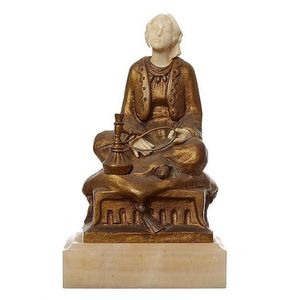Qing Dynasty Chinese Deity Figure on Ox
You must be a subscriber, and be logged in to view price and dealer details.
Subscribe Now to view actual auction price for this item
When you subscribe, you have the option of setting the currency in which to display prices to $Au, $US, $NZ or Stg.
- Polychrome - Made or finished in many colours. For furniture, it is used to indicated a painted finish.
- Qing Dynasty - The Qing Dynasty was the last imperial dynasty of China, ruling from 1644 to 1912. It was established by the Manchu people, who originated from the northeastern region of China. The Qing Dynasty was preceded by the Ming Dynasty and followed by the Republic of China.
- Distressed - Usually applied to describe the condition of an item of furniture, and means that the object is extremely worn and is verging on being unsuitable for its intended use, without some restoration or repairs being undertaken.
Furniture can also be artificially distressed, by deliberate infliction of superficial damage to make it appear old. Artificial distressing can be done with the object of deceiving a purchaser, where the object is being passed off as "of the period", or can be done for aesthetic reasons so that a new object is made to appear as though it has been in use. - Ming Dynasty - The Ming Dynasty was a ruling dynasty of China from 1368 to 1644. It succeeded the Yuan Dynasty and preceded the Qing Dynasty. The Ming Dynasty was established by Zhu Yuanzhang, a former Buddhist monk who became a rebel leader and eventually overthrew the Mongol Yuan Dynasty. During the Ming Dynasty, China experienced a period of relative stability and prosperity. The government was centralized and bureaucratic, with the emperor at the top of the hierarchy. The Ming Dynasty is known for its cultural achievements, including the development of porcelain, the invention of movable type printing, and the construction of the Great Wall of China.
Visually similar items

An American Art Deco ivory and gilt bronze 'Hookah' figure by H. M. White, circa 1900, depicting a seated figure in eastern dress sitting cross legged on a cushion and stool with hookah, engraved signature, 7.5 cm high (including marble plinth).

Antique Chinese Ming Dynasty figural three colour glazed terracotta roof tile, with fitted later carved wood stand ex Christies private collection, 17 cm high

A bronze Buddha. Seal at back. Height 25 cm

A bronze cloisonne Sakyamuni statue, with cloisonne decoration, sitting in lotus seat, hands showing Dhyana-Mudra with a small bowl in palm of hands, 19.5 cm high
